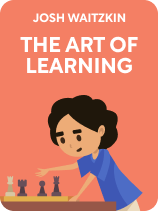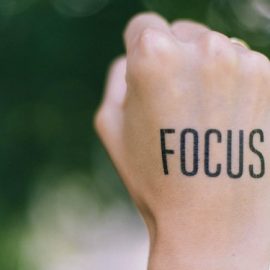

This article is an excerpt from the Shortform book guide to "The Art of Learning" by Josh Waitzkin. Shortform has the world's best summaries and analyses of books you should be reading.
Like this article? Sign up for a free trial here .
How do you develop a skill in the most effective and efficient way possible? Is there a method to make mastering skills easier?
According to Josh Waitzkin, the author of The Art of Learning, the fastest and most effective way to master a skill is to build individual elements of the skill into memory “chunks.” Memory chunks are combinations of multiple elements, like how to shuffle, deal, and count cards—and networks of chunks.
Here’s how to develop a skill and make it stick, according to Waitzkin.
Start With the Fundamentals
With any skill, there are better and worse ways to begin learning. Waitzkin recommends a patient, step-by-step approach to the fundamentals.
First, avoid beginning with rigid, quick-fix strategies that only work in specific scenarios. For example, Waitzkin explains that many young chess players learn aggressive sequences of moves that aim to overwhelm an unskilled opponent. However, these players don’t understand the inner workings of their strategies. So when they face situations that surpass their knowledge, and their strategies fall apart, they aren’t equipped to adapt. This sort of player has a brittle, one-dimensional game plan.
(Shortform note: Many language learning programs, like Duolingo and Rosetta Stone, make the mistake Waitzkin cautions against: They teach you set phrases and sentences that apply only if people speak precisely what you’ve learned. Since people don’t speak so rigidly, this knowledge can quickly fall apart, just as Waitzkin argues. In contrast, Gabriel Wyner explains in Fluent Forever that we should learn languages from the bottom up, starting from the sounds, moving to single words, to grammatical patterns, and interspersing conversation practice to tie it all together.)
The better approach, according to Waitzkin, is to start by studying the basic elements of your skill. Any skill is composed of simple, elemental chunks of know-how. For example, you’d learn how to dribble a basketball, how to pass it, how to catch it, and so on.
Study each element in isolation, one by one, taking the time to thoroughly understand each one. In chess, Waitzkin first studied king-pawn versus king, a basic situation that teaches the simplest principles. Afterward, he moved on to rook-pawn versus king, and so on, through each basic chess position. In basketball, you might first learn to dribble, then to pass, to set up a shot, to pivot, and so on—giving each your undivided attention.
(Shortform note: Though Waitzkin doesn’t say it explicitly, this approach is much like deep practice, a method of refining one technique at a time through focused practice. In The Talent Code, Daniel Coyle gives a similar explanation, saying that deep practice combines single-element focus with a tight feedback loop, enabling you to adjust and refine one skill at a time. For example, you would learn a piece of music one bar at a time, practicing each repeatedly and correcting your mistakes until you can perform it properly. Focus on refining that element until you’ve got it down—otherwise, you risk sloppy, unrefined execution.)
Patiently practice each element until it becomes intuitive. Waitzkin calls this form to leave form, referring to the process whereby a conscious effort gradually becomes unconscious, or automatic. For example, if you drill 10,000 free throws, your form will eventually become second nature.
Once each element is intuitive, start combining them. Continue to practice until you can unconsciously coordinate multiple basic elements of your skill. For example, you might train basketball techniques until you can stop on a dime, catch a bounce pass, dribble to the three-point line, and shoot a jump shot. Practice these one at a time, and you’ll build smooth, coordinated skillfulness.
(Shortform note: In The Talent Code, Coyle also discusses how deep practice develops myelin more efficiently than unfocused practice. Myelin is a tissue that wraps around neurons or nerve cells, speeding and smoothing the signals that travel along those cells. The more myelin you’ve grown, the more automatically you can perform a practiced behavior. In other words, myelin makes your skills habit, or intuitive. This is the neuroscience of Waitzkin’s “form to leave form”: Dedicated practice of individual skills develops myelin, and well-myelinated skills feel like natural instinct.)
This method has two major benefits:
Benefit #1: It builds resilient skillfulness. Because you’ve trained the basic elements of your skill in isolation, you’ve set yourself up to combine them in new ways when you encounter new situations. So when the obstacles get tougher, you’ll be able to adapt.
- For example, understanding a language from the bottom up—basic sounds, to words and grammar patterns, to phrases and sentences—is better than learning a collection of set phrases. In the latter situation, you’re out of luck if people say anything other than what you learned. In the former, you have a shot at adapting because you aren’t limited to a few rigid constructions.
Benefit #2: It emphasizes the process. Learning the basic elements one at a time encourages you to find meaning in the labor of committed practice. So in addition to a solid technical foundation, you foster an appreciation for the journey of growth.
| How to Develop a Skill: Waitzkin’s Method A common critique of The Art of Learning is that Waitzkin doesn’t provide examples from outside of chess or tai chi. While he does explain most of the above principles from his experience with those two disciplines, considering how they’d apply to other skills shows that the principles do make sense—let’s see how: In language learning, you would study a language from the bottom up: – The basic elements: Start by learning to pronounce each individual sound. – Practice until intuitive: In practicing each individual sound, you’ll need to wrap your tongue around unfamiliar consonants and vowels, repeating until they feel natural. – Put the elements together: Now you can combine sounds into words, which are many sounds in tandem. If you try to say “Freundschaftsbeziehungen” before learning each sound, you’re in for a rough ride.Continue on to grammar rules, phrases, sentences, and more. On piano, you could learn one note, chord, and scale at a time: – The basic elements: Start by learning the 12 notes of the chromatic scale (which contains all 12 notes in Western music). – Practice until intuitive: Press one key at a time, refining your form until you can smoothly play each note without thinking. – Put the elements together: Pick a basic chord, like a C major, to combine three notes into one technique. Again, practice until it’s natural; and so on with further chords and scales. |

———End of Preview———
Like what you just read? Read the rest of the world's best book summary and analysis of Josh Waitzkin's "The Art of Learning" at Shortform .
Here's what you'll find in our full The Art of Learning summary :
- Life advice from chess prodigy and tai chi World Champion Josh Waitzkin
- Detailed looks at the psychological and technical sides of skill-building
- How to build any skill from the bottom-up






